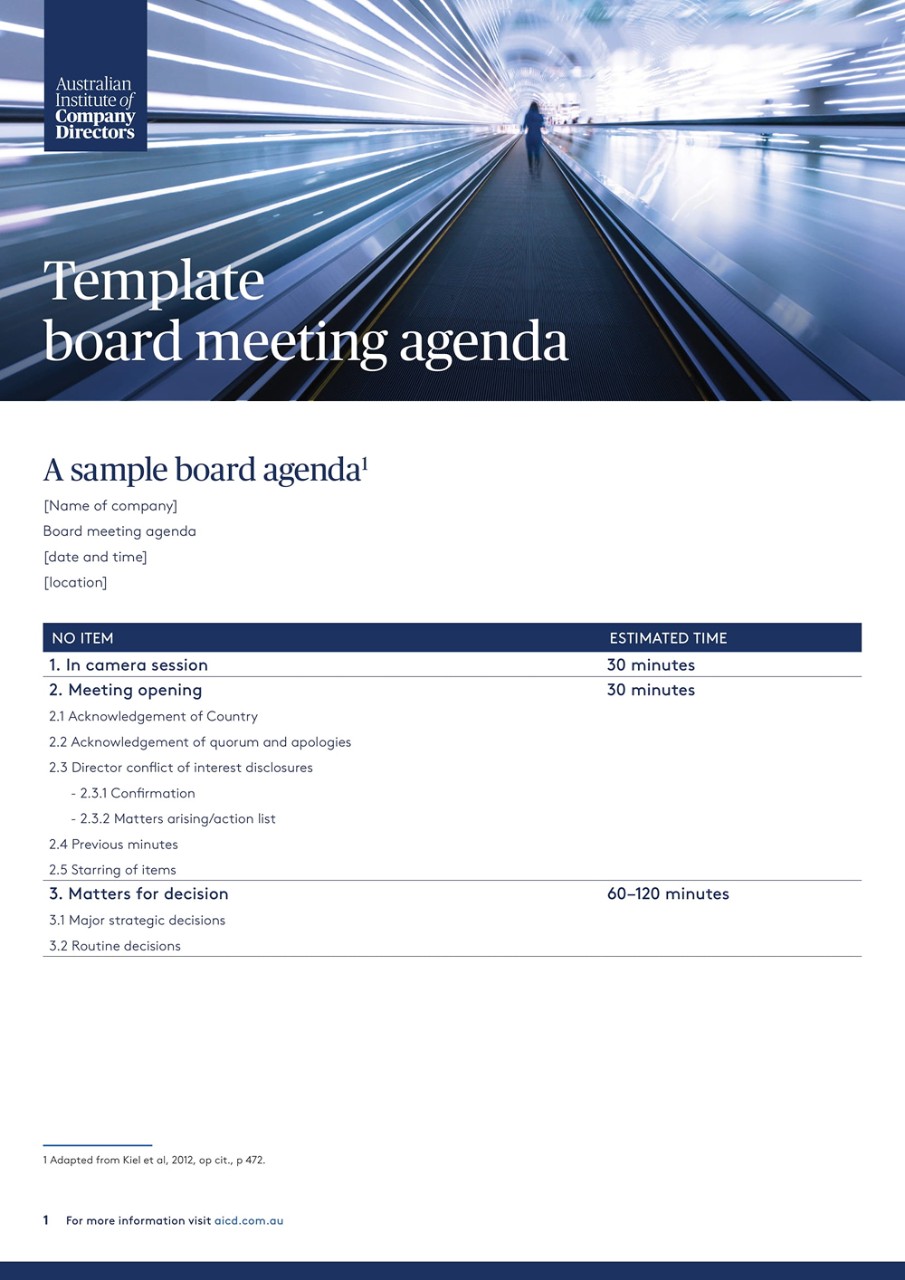The purpose of a board meeting agenda is to improve the effectiveness of board meetings. It is the tool the chair uses to keep boardroom discussions focused. Although each board will have an agenda that reflects specific topics of relevance to a company at that time, a number of general items will be included on most agendas.
A good agenda alerts directors about issues that will be discussed at the meeting. It can help executives prepare to discuss issues with the board and to develop related board papers. An agenda helps the chair ensure that all issues are dealt with in an appropriate order and depth during the meeting.
A well-designed agenda allows directors to add value and avoid trouble by better contributing to the organisation’s longterm strategies by adding future-oriented topics to the agenda. For example, in a time of rapid change, increased complexity and uncertainty, boards worldwide are faced with issues such as how they can effectively monitor corporate culture, digital disruption, cyber security, the implications of artificial intelligence and the need for innovation. The question is, when does the board get time to discuss these matters; the answer is by adding them to their annual calendar and meeting agendas.
An important part of designing an agenda is the screening process. Given the range of issues and limited time that most boards will have to deal with them, it is important for an agenda to include only those items that are ripe for productive discussion, and where some decision can be reached. If the item is not developed enough for productive discussion and more information is needed, it may be appropriate to delay inclusion until a later meeting. Similarly, if there is insufficient time to prepare accompanying documentation to aid decision-making, it is often better, if at all possible, to leave the item until another meeting.
Deciding what to put on the board meeting agenda is a process that commences as soon as the previous meeting ends. Apart from the standard items included in every agenda such as director conflict of interest disclosures and the CEO’s report, the agenda and minutes from the previous meeting should be consulted so that any items that were carried over are certain to be included.
The agenda is usually prepared by the chair with assistance from either the CEO, the board secretary, or both. Sometimes the chair will draft the agenda and the others will review it. Other times it is done in a meeting with all contributing, and occasionally it will be drafted by an executive with the chair providing comment or revising the draft. Most chairs will invite the other directors to contribute ideas for the agenda. This may happen annually, before each meeting, or both. The chair, however, has the final say on what appears on the agenda.
Points to consider
The following should always be recorded:
- Who was invited to the meeting.
- Any person absent for specific agenda items (important for managing conflicts of interest).
- Meeting start-time, location, and expected end-time. Some companies assign a unique meeting number. If used, this number should be included on the agenda; otherwise, the date will suffice.
- A good agenda lists all business items and clearly states the intended outcome: decision, discussion, noting (formal acknowledgment), or an information session.
- Clearly note any urgent decision-making requirements. Some decisions cannot be deferred, requiring directors to arrive prepared to act.
- Prioritize the most important agenda items. For instance, strategic decisions can be placed under ‘Matters for Decision’ early in the meeting when directors’ energy and focus are highest.
- Allocate appropriate time for each item to ensure adequate attention.
- Include an in-camera session in the agenda, allowing non-executive directors to discuss issues without management present. Regular inclusion of these sessions reduces any perceived threat to management. In-camera sessions are not for decision-making; those decisions should occur elsewhere in the agenda.
- Many boards use an annual agenda (outlined in the board calendar) to evenly distribute major topics throughout the year, aiding in effective meeting agenda design.
- Divide the agenda into clearly defined stages or sections to effectively manage time and focus discussions.
- Employ a starring system to enhance efficiency by distinguishing non-controversial items from those requiring discussion. Items needing discussion (‘starred items’) are marked with an asterisk (*). Directors can request any agenda item be starred. Un-starred items are approved without discussion, according to the draft resolution provided. Starred items receive individual attention during the meeting, while un-starred items are automatically approved or noted based on their draft resolutions.
Latest Director Tools
Already a member?
Login to view this content


